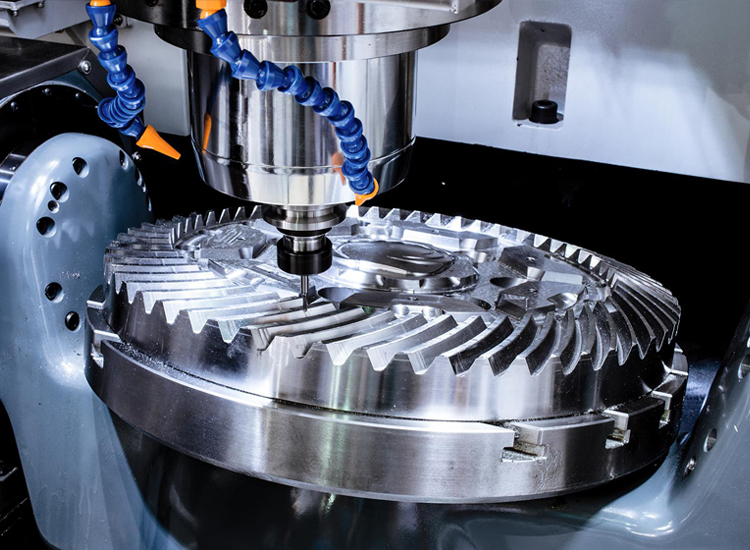Application of 3D Printing Technology in Precision Casting Industry
- Categories:News
- Author:
- Source:
- Time:2021-07-30
- Visits:0
[Summary]Rapid prototyping manufacturing technology is the focus of attention in the world today. As a traditional process, casting can obtain castings with complex shapes, large volumes, low manufacturing costs and high flexibility. Give full play to their characteristics and advantages, and obtain objective economic benefits in the trial production of new products.
Application of 3D Printing Technology in Precision Casting Industry
[Summary]Rapid prototyping manufacturing technology is the focus of attention in the world today. As a traditional process, casting can obtain castings with complex shapes, large volumes, low manufacturing costs and high flexibility. Give full play to their characteristics and advantages, and obtain objective economic benefits in the trial production of new products.
- Categories:News
- Author:
- Source:
- Time:2021-07-30
- Visits:0
Rapid prototyping manufacturing technology is the focus of attention in the world today. As a traditional process, casting can obtain castings with complex shapes, large volumes, low manufacturing costs and high flexibility. Give full play to their characteristics and advantages, and obtain objective economic benefits in the trial production of new products.
1. Three-dimensional printing includes SLS, SLA, SLM and other three-dimensional printing forming methods. Different from the traditional manufacturing method, 3D printing is based on the CAD geometric model of the part, through the software layered discrete numerical control forming system, using laser beams or other methods to accumulate materials to form solid parts, so it is also called fit. Aluminum additive manufacturing method. Because it transforms complex three-dimensional manufacturing into a series of two-dimensional manufacturing superimpositions, almost any complex shape parts can be generated without the use of molds and tools, which greatly improves production efficiency and manufacturing flexibility.
2. Combined with manufacturing methods such as NC processing, casting, metal cold spraying, and silicone molds, rapid automatic prototyping has become a powerful means of modern molds, molds and parts manufacturing. It is an effective method to realize single batch or small batch agile manufacturing of metal parts suitable for my country's national conditions. It is used in aerospace, automobiles, motorcycles and other fields, and household appliances and other fields have been widely used. 3D printing technology can quickly provide wax or disappearing foam for wood or sand molds of precision casting and sand casting. It solves the problems of traditional castings, such as long preparation cycle, large investment, and difficult manufacturing of complex parts such as curved surfaces. Precision casting technology (including plaster casting) and sand casting technology are very mature technologies in my country. The organic combination of these two technologies achieves low-cost, high-efficiency production, and achieves the goal of rapid manufacturing.
3. The process of 3D printing is to first generate a 3D CAD solid model or surface model file of the product, convert it into a specific file format, and then use the corresponding software to "cut" a series of thickness layers from the file, or directly from Cut a series of layers in C. Advertising files. These layers accumulate sequentially and maintain the shape of the designed part. Then, the data of each layer is transferred to the rapid prototyping machine. Using material addition method and laser as heating source, each layer is sintered or melted in turn, and connected to each layer at the same time, until the entire part is completed. The molding material is a sinterable powder, such as paraffin wax, plastic, low melting point metal powder or mixed powders thereof. Compared with traditional methods, 3D printing technology has unique advantages. Its characteristics are as follows:
4. It is conducive to the integration of the design process and the manufacturing process, digitizing the entire production process, and has a direct relationship with the CAD model. WYSIWYG parts can be modified and manufactured at any time, thereby alleviating the CAPP bottleneck in the CAD/CAM process of complex structural parts.
5. Part materials that cannot be manufactured by traditional methods, such as gradient material parts and multi-material parts, are conducive to the design of new materials.
6. Greatly reduce the manufacturing cycle and cost of rough molds for complex parts. When engineering materials are used to directly form mechanical parts, it is no longer necessary to design and manufacture blank forming molds.
7. The near-net shape of the blank is realized, the processing allowance is greatly reduced, the material waste is avoided, the energy consumption is reduced, and it is conducive to environmental protection and sustainable development.
8. As the time and cost of process preparation are greatly reduced, the cycle and cost of single trial production and small batch production are greatly reduced, especially the development of new products and the production of small batches of parts.
9. Combined with traditional methods, the functions of rapid casting, rapid mold manufacturing and small batch production of parts are realized, which injects new vitality into traditional manufacturing methods.
10. Precision casting is one of the most accurate casting methods. The accuracy is generally better than 0.5%, and the repeatability is good. Castings can be put into use with only a small amount of machining. Since the die-casting mold is disposable, it can manufacture parts with complex internal structures. These parts can be forged or machined parts that cannot be produced. Although precision casting has many advantages, its production process is complicated and long. Aluminum mold pressing wax mold usually takes several weeks to several months, depending on the complexity and size of the aluminum mold. It takes several weeks to get the casting after getting the aluminum mold. These weeks are mainly used to make mold shells. In addition to time-consuming, precision casting is also very labor-intensive, with 50% to 80% of the cost coming from handwork. In addition, the cost of molds in small batch production is also shared, making the unit price expensive. 3D printing and precision casting are complementary. Both of these methods are suitable for manufacturing parts with complex shapes. If there is no rapid automatic prototyping, the production of casting molds is the bottleneck process of precision casting, but if there is no precision casting, the application of rapid automatic prototyping will have great limitations.
1. The application of 3D printing technology in precision casting can be divided into three categories:
1. It is the processing process of lost foam parts (molds) produced in small batches.
2. It is the direct shell method, used for small-scale production.
3. Mass production and rapid wax mold manufacturing.
In the manufacturing industry, especially aviation, aerospace, national defense, automobile and other industries, the basic core components are generally metal parts, and a considerable part of the metal parts are asymmetrical, with irregular surfaces or complex structures, and fine internal parts. These parts are usually produced by casting or disassembly. Rapid casting is one of the most attractive methods for copying metal parts using a 3D printer as a master or transitional model. This is because the casting process can produce parts with complex shapes. In casting production, the manufacturing of templates, core boxes, wax molds and die-casting molds usually uses mechanical processing methods. Sometimes a repairman is needed to fix it. The cycle is long and the cost is high. From mold design to processing and manufacturing is a complex process with multiple links. Minor mistakes can cause all rework.
Especially for complex castings such as blades, impellers, engine blocks, cylinder heads, etc., mold manufacturing is a very difficult process. Even with the use of expensive equipment such as CNC machining centers, there are still great difficulties in processing technology and process feasibility. Combine 3D printing technology with traditional technology, give full play to its own advantages, avoid its own weaknesses, and get twice the result with half the effort. 3D printing technology is used to directly make wax molds, and the rapid casting process does not need to open the mold, which greatly saves the production cycle and cost. Figure 2 shows the wax model and castings of a four-cylinder engine produced by the rapid casting method. According to the traditional metal casting method, the mold manufacturing cycle is about half a year, and the cost is several hundred thousand yuan. Using rapid casting method, 3 days 3D printing investment casting, 10 days casting, the entire trial production task is 5 months ahead of the original plan.
Precision casting is commonly used to make steel parts from 3D printing. But for low melting point metal parts, such as aluminum-magnesium alloy parts and gypsum castings, its efficiency is higher. At the same time, the quality of the castings is effectively guaranteed and the success rate of the castings is improved. In the process of plaster mold casting, three-dimensional printing is still a lost pattern, and then the plaster mold is obtained to obtain the required metal parts. Plaster casting is to use 3D printed parts to make lost foam, then use 3D printing in plaster paste to embed the disappeared foam in the plaster mold, and then put the plaster mold into an incubator to incubate.
In this way, the disappeared foam of 3D printing is decomposed by high temperature, and finally disappears completely. At the same time, the plaster mold dries and hardens. This process usually takes about two days. In a dedicated vacuum casting equipment, the molten aluminum alloy is poured into the plaster mold. After cooling, the metal parts are obtained by crushing the plaster mold. The cost of producing metal parts by this method is very low, generally only 2%-5% of the production of die-casting molds. The production cycle is very short, usually only 2-3 weeks. The performance of gypsum castings can also be compared with precision castings. Since the gypsum casting is completed in a vacuum environment, its performance is even better than ordinary precision casting.
Scan the QR code to read on your phone
CONTACT US
SCAN QR CODE

Scan And Follow Us
MESSAGE
© 2021金年会中国金年会登录 All Rights Reserved 豫ICP备2020034136号-1
- Contact Us
- whatsapp 0373-2163365
- Hotline 0373-2163365
- Email xxzhenxin@126.com
- Back To Top




